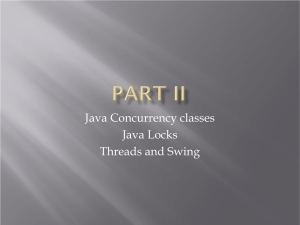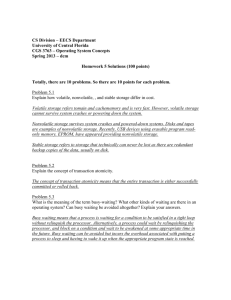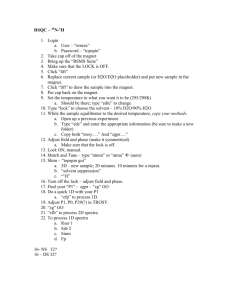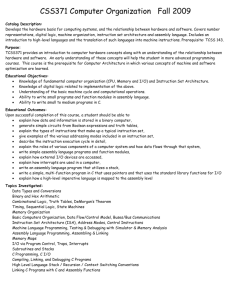Lecture Note V
advertisement
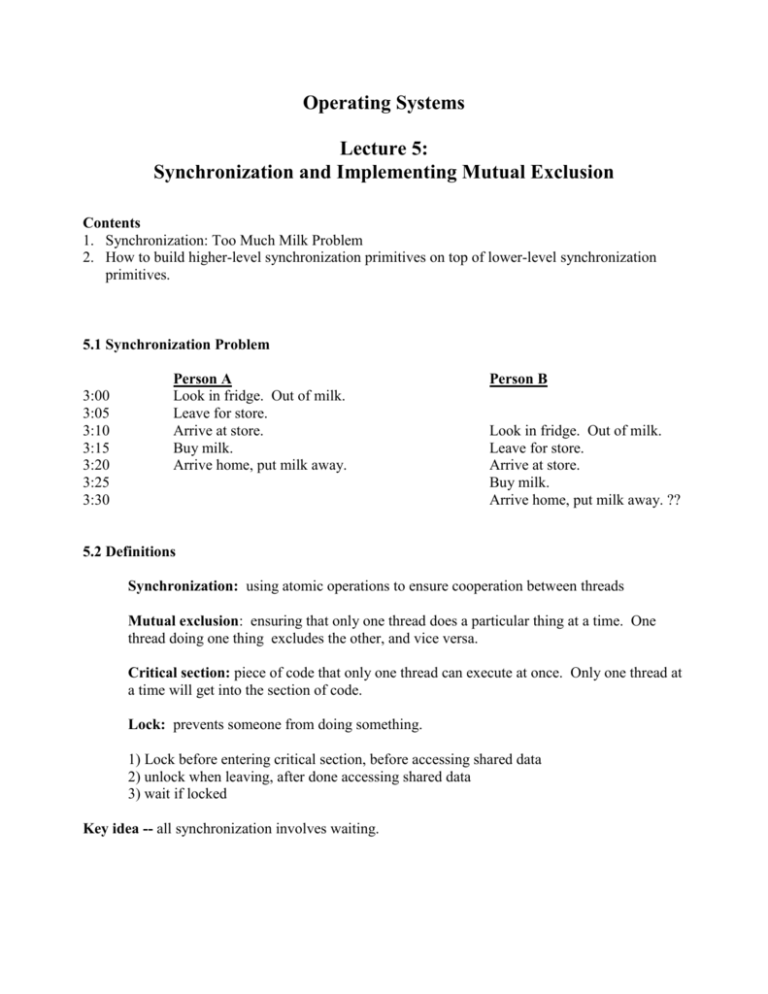
Operating Systems
Lecture 5:
Synchronization and Implementing Mutual Exclusion
Contents
1. Synchronization: Too Much Milk Problem
2. How to build higher-level synchronization primitives on top of lower-level synchronization
primitives.
5.1 Synchronization Problem
3:00
3:05
3:10
3:15
3:20
3:25
3:30
Person A
Look in fridge. Out of milk.
Leave for store.
Arrive at store.
Buy milk.
Arrive home, put milk away.
Person B
Look in fridge. Out of milk.
Leave for store.
Arrive at store.
Buy milk.
Arrive home, put milk away. ??
5.2 Definitions
Synchronization: using atomic operations to ensure cooperation between threads
Mutual exclusion: ensuring that only one thread does a particular thing at a time. One
thread doing one thing excludes the other, and vice versa.
Critical section: piece of code that only one thread can execute at once. Only one thread at
a time will get into the section of code.
Lock: prevents someone from doing something.
1) Lock before entering critical section, before accessing shared data
2) unlock when leaving, after done accessing shared data
3) wait if locked
Key idea -- all synchronization involves waiting.
5.3 Solutions -- Assuming that only load and store operations are atomic building bloks!!
5.3.1 Too Much Milk: Solution #1
What are the correctness properties for the too much milk problem?
never more than one person buys
someone buys if needed
Basic idea of solution #1:
1. Leave a note (kind of like "lock")
2. Remove note (kind of like "unlock")
3. don't buy if note (wait)
Solution #1:
if (noMilk) {
if (noNote){
leave Note;
buy milk;
remove note;
}
}
Why doesn't this work?
??
Our "solution" makes problem worse -- fails only occassionally.
Makes it really hard to debug. Remember, constraint has to be satisfied, independent of what the
dispatcher does -- timer can go off, and context switch can happen at any time.
5.3.2 Too Much Milk: Solution #2
How about labeled notes? That way, we can leave the note before checking the milk.
Thread A
leave note A
if (noNote B){
if (noMilk)
buy milk
}
remove note A
Why doesn't this work?
Thread B
leave note B
if (noNoteA){
if (noMilk)
buy milk
}
remove note B
??
5.3.3 Too Much Milk: Solution #3
Thread A
leave note A
while (note B) // X
do nothing;
if(noMilk)
buy milk;
remove note A
Thread B
leave note B
if (noNoteA){ // Y
if (noMilk)
buy milk;
}
remove note B
Does this work? Yes. Can guarantee at X and Y that either
(i) safe for me to buy
(ii) other will buy, ok to quit
At Y: What happens??
At X: What happens??
5.4 Too Much Milk: Summary
Solution #3 works, but it's really unsatisfactory:
1. really complicated -- even for this simple an example, hard to convince yourself it really works
2. A's code different than B's -- what if lots of threads? Code would have to be slightly different
for each thread.
3. While A is waiting, it is consuming CPU time ( busy- waiting )
There's a better way: use higher-level atomic operations; load and store are too primitive. For
example, why not use locks as an atomic building block (how we do this in the next lecture):
Lock::Acquire -- wait until lock is free, then grab it
Lock::Release -- unlock, waking up a waiter if any
These must be atomic operations -- if two threads are waiting for the lock, and both see it's free,
only one grabs it!
With locks, the too much milk problem becomes really easy!
lock->Acquire();
if (nomilk)
buy milk;
lock->Release();
5.5 Implementing Mutual Exclusion
Concurrent Programs
Higher-level
atomic operations
Low level
atomic operations
LOCKS
SEMAPHORES
load/store
MONITORS
COND. VAR.
SEND&RECEIVE
interrupt disable
test&set
Relantionship among synchronization abstraction
Too much milk example showed that implementing a concurrent program directly with loads and
stores would be tricky and error-prone. Instead, a programmer would benefit from higher level
operations, such as locks.
In this lecture we will see :
how do we implement these higher level operations?
what higher-level primitives make it easiest to write correct concurrent programs?
5.6 Ways of implementing locks
All require some level of hardware support
5.6.1 Atomic memory load and store
Remember too much milk lecture!
5.6.2 Directly implement locks and context switches in hardware.
Implemented in the Intel 432. Makes hardware slow!
5.6.3 Disable interrupts (uniprocessor only)
Two ways for dispatcher to get control:
internal events -- thread does something to relinquish the CPU
external events -- interrrupts cause dispatcher to take CPU away
On a uniprocessor, an operation will be atomic as long as a context switch does not occur in the
middle of the operation. Need to prevent both internal and external events. Preventing internal
events is easy. Prevent external events by disabling interrupts, in effect, telling the hardware to
delay handling of external events until after we're done with the atomic operation.
5.6.3.1 Busy-waiting solution
class Lock {
int value = FREE;
}
Lock::Acquire() {
Disable interrupts;
while (value != FREE) {
Enable interrupts; // allow interrupts
Disable interrupts;
}
value = BUSY;
Enable interrupts;
Lock::Release()
Disable interrupts;
value = FREE;
Enable interrupts;
Why do we need to disable interrupts at all?
Why do we need to enable interrupts inside the loop in Acquire?
Why might this be a bad solution?
Busy-waiting: thread consumes CPU cycles while it is waiting. Not only is this inefficient, it could
cause problems if threads can have different priorities. If the busy-waiting thread has higher
priority than the thread holding the lock, the timer will go off, but (depending on the scheduling
policy), the lower priority thread might never run. Also, for semaphores and monitors, if not for
locks, waiting thread may wait for an arbitrary length of time. Thus, even if busy-waiting was OK
for locks, it could be very inefficient for implementing other primitives.
5.6.3.2 Solution without busy-waiting
Waiter gives up the processor so that Release can go forward more quickly:
Lock::Acquire()
Disable interrupts;
while (value != FREE) {
put on queue of threads waiting for lock
go to sleep
}
value = BUSY;
Enable interrupts;
Lock::Release()
Disable interrupts;
if anyone on wait queue {
take a waiting thread off
put it on ready queue
}
value = FREE;
Enable interrupts;
When does Acquire re-enable interrupts in going to sleep?
Before putting the thread on the wait queue?
After putting the thread on the wait queue, but before going to sleep?
*** To fix this: in Nachos, interrupts are disabled when you call Thread::Sleep; it is the
responsibility of the next thread to run to re-enable interrupts.
When the sleeping thread wakes up, it returns from Sleep back to Acquire. Interrupts are still
disabled, so it's OK to check lock value, and if it's free, grab the lock, and then turn on interrupts.
Time
Thread A
.
.
.
disable
sleep
Thread B
switch
sleep return
enable
.
.
.
disable
sleep
switch
sleep return
enable
.
.
Interrupt disable and enable pattern across context switches
5.6.3.3 Why not do the following:
Lock::Acquire() { disable interrupts; }
Lock::Release() { enable interrupts; }
1. Critical section may be in user code, and you don't want to allow user code to disable interrupts
(might never give CPU back!). In the earlier schemes, the implementation of lock acquire and
release would be done in the protected part of the operating system, but they could be called by
arbitrary user code.
2. Might want to take interrupts during critical section. For instance, what if the lock holder takes
a page fault? Or does disk I/O?
3. Many physical devices depend on real-time constraints. For example, keystrokes can be lost if
interrupt for one keystroke isn't handled by the time the next keystroke occurs. Thus, want to
disable interrupts for the shortest time possible. Critical sections could be very long running.
4. Simple solution might work for locks, but wouldn't work for semaphores or condition variables.
5.6.4 Atomic read-modify-write instructions
On a multiprocessor, interrupt disable doesn't provide atomicity. It stops context switches from
occuring on that CPU, but it doesn't stop other CPUs from entering the critical section. Instead,
every modern processor architecture provides some kind of atomic read-modify-write instruction.
These instructions atomically read a value from memory into a register, and write a new value.
The hardware is responsible for implementing this correctly on both uniprocessors (not too hard)
and multiprocessors (requires changes in the multiprocessor cache coherence strategy).
Unlike disabling interrupts, this can be used on both uniprocessors and multiprocessors.
5.6.4.1 Examples of read-modify-write instructions:
1.
2.
3.
4.
test&set (most architectures) -- read value, write 1 back to memory
exchange (x86) -- swaps value between register and memory
compare&swap (68000) -- read value, if value matches register, do exchange
load linked and conditional store (R4000, Alpha) -- designed to fit better with load/store
architecture. Read value in one instruction, do some operations, when store occurs, check if
value has been modified in the meantime. If not, ok. If it has changed, abort, and jump back to
start.
5.6.4.2 Implementing locks with test&set
Test&set reads location, sets it to 1, and returns old value.
Initially, lock value = 0;
Lock::Acquire
while (test&set(value) == 1) // while BUSY ;
Lock::Release
value = 0;
If lock is free, test&set reads 0 and sets value to 1, so lock is now busy. It returns 0, so Acquire
completes. If lock is busy, test&set reads 1 and sets value to 1 (no change), so lock stays busy, and
Acquire will loop.
This is a busy-wait loop, but as with the discussion above about disable interrupts, you can modify
it to sleep if lock is BUSY.
5.6.5 Summary
Load/store, disabling and enabling interrupts, and atomic read-modify-write instructions, are all
ways that we can implement higher level atomic operations.

